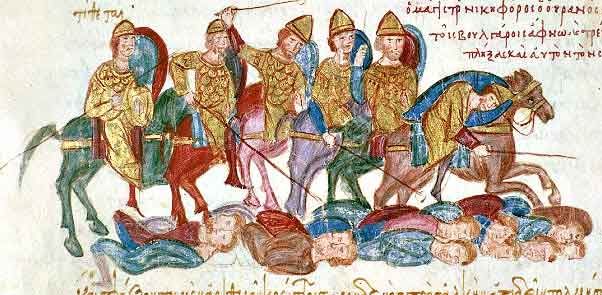.

Miniature depicting Bulgars put to flight by Nikephoros Ouranos at the Spercheios river, from the Chronicle of John Skylitzis, mid-12th to mid-13th century, Madrid, Biblioteca Nacional.
Nikephoros Ouranos (Gr. Νικηφορος Ουρανος) was the Byzantine strategos of Antiocheia from 999 to circa 1010. He also led the army that crushed the Bulgars and wounded their Tsar Samuil at the Spercheios River in 996 or 7. This was during the reign of Basil II the Bulgar-Slayer. Ouranos composed a Taktika on the basis of his experiences, copying but expanding the earlier work of Nikephoros II Phokas.
Chapter 65, dealing with siegecraft, is notable for the importance given to psychological and diplomatic factors during a siege. For instance, he notes it is important to take precautions even against Christian subjects supplying a Muslim enemy with grain, cheese or livestock because the high price offered with otherwise prove tempting. Likewise, he suggests alternating between gracious offers of clemency and harsh threats of reprisals (especially against Armenian and Syriac Christians, apostates to Islam (Gr. μαγαριται), and other heretics) whether one plans to honor these or not, as such vacillation will produce dissension among the defenders.
Oddly enough, though Ouranos refers to trebuchets, it appears he - and by extension the Byzantines - used them against the defenders along the walls, and not against the walls themselves. Apparently in ignorance of the destructive power at his command, he writes: "The men of old, in their pursuit of siege warfare, constructed many devices such as battering rams, wooden towers, scaling ladders with various features, tortoises, and all kinds of other things which our generation can hardly imagine. It has, however, tried all these devices and found that out of all of them, the most effective way, one the enemy cannot match, is undermining the foundations..."
Ouranos was also a pious man, attempting to live a monkish life without disengaging from worldly affairs. He authored two known hagiographical texts, the metaphrasis The Life of Symeon of the Wondrous Mountain and The Passion of Theodore the Recruit.
Sources
- Taktika by Nikephoros Ouranos
- Sowing the Dragon's Teeth by Eric McGeer
- "Byzantine Siege Warfare in Theory and Practice" by Eric McGeer from The Medieval City under Siege
- Fainting fits and their causes: a topos in two Middle Byzantine metaphraseis by Nicetas the Paphlagonian and Nicephorus Ouranos by Dirk Krausmüller from Gouden Hoorn Tijdschrift over Byzantium Vol. 9, 1.
| Ancient Greece
Science, Technology , Medicine , Warfare, , Biographies , Life , Cities/Places/Maps , Arts , Literature , Philosophy ,Olympics, Mythology , History , Images Medieval Greece / Byzantine Empire Science, Technology, Arts, , Warfare , Literature, Biographies, Icons, History Modern Greece Cities, Islands, Regions, Fauna/Flora ,Biographies , History , Warfare, Science/Technology, Literature, Music , Arts , Film/Actors , Sport , Fashion --- |
Retrieved from "http://en.wikipedia.org"
All text is available under the terms of the GNU Free Documentation License

